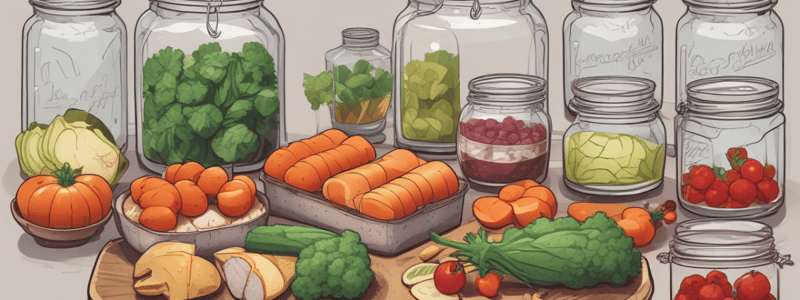Podcast
Questions and Answers
Explain the main benefits of salt-curing for meat and fish.
Explain the main benefits of salt-curing for meat and fish.
Salt-curing offers several benefits, including inhibiting bacterial growth, enhancing tenderness through protein breakdown, and creating a dense, chewy texture due to dehydration.
Why are tender cuts of meat, like tenderloin or shrimp, not ideal for salt curing?
Why are tender cuts of meat, like tenderloin or shrimp, not ideal for salt curing?
Tender cuts of meat and seafood like tenderloin or shrimp would become excessively soft and gain little in flavor from the curing process, resulting in an undesirable texture and potentially a strange aftertaste.
Describe the effect of salt on the flavor profile of cured meat or fish.
Describe the effect of salt on the flavor profile of cured meat or fish.
Salt-curing introduces a subtle sweetness and a slight twang to the flavor of meat or fish, due to the fermentation process that occurs during the curing.
How does salt curing contribute to the texture of cured meats like ham, lox, or bacon?
How does salt curing contribute to the texture of cured meats like ham, lox, or bacon?
What are some examples of meats and fish that are particularly well-suited for salt curing?
What are some examples of meats and fish that are particularly well-suited for salt curing?
What type of vegetables are generally not suitable for salt curing? Explain why.
What type of vegetables are generally not suitable for salt curing? Explain why.
Explain how salt curing affects the bacterial growth in meat and fish.
Explain how salt curing affects the bacterial growth in meat and fish.
Compare and contrast the effects of salt curing on meat and fish with those of smoking or brining.
Compare and contrast the effects of salt curing on meat and fish with those of smoking or brining.
How does salt curing contribute to the overall quality of cured meat or fish?
How does salt curing contribute to the overall quality of cured meat or fish?
Explain the historical significance of salt curing and its impact on food preservation.
Explain the historical significance of salt curing and its impact on food preservation.
Flashcards are hidden until you start studying
Study Notes
Introduction to Food Preservation
- Food is composed of biochemical compounds derived from animals and plants
- Major constituents of food: carbohydrates, proteins, and fats
- Minor constituents of food: minerals, vitamins, enzymes, acids, antioxidants, pigments, and flavor substances
- Foods are subject to physical, chemical, and biological deterioration
Factors Affecting Food Spoilage
- Growth and activities of microorganisms (bacteria, yeast, and molds)
- Activities of food enzymes and other chemical reactions within food
- Infestation by insects and rodents
- Inappropriate temperature for a given preserved food
- Gain or loss of moisture
- Reaction with oxygen
- Light presence
Food Preservation Definition
- Food preservation is the process of treating and handling food to stop or greatly slow down spoilage
- Preservation involves preventing growth of bacteria, fungi, and other organisms, and retarding fat oxidation
History of Food Preservation
- Food preservation has been practiced in all cultures at different points in time
- Ancient cultures used different methods of food preservation, such as storing and processing items like herbs, spices, meats, fruits, and vegetables
- Major milestone in food preservation history was in the 19th century with the discovery of canning and pasteurization
Methods of Food Preservation
Drying
- Drying is one of the oldest methods of preservation for later use of food
- Drying preserves food by removing moisture, making it difficult for bacteria, yeast, and mold to grow
- Drying slows down the action of enzymes
- Methods of drying: sun drying, oven drying, and dehydrators
Fermentation
- Fermentation was discovered, not invented
- Fermentation is a natural process that occurs when microorganisms convert sugars into alcohols or acids
- Benefits of fermentation: enhances flavor, makes food digestible, enhances nutritional values, and suppresses helicobacter pylori
- Examples of fermented foods: beer, wine, kimchi, sauerkraut, and yogurt
Curing and Pickling (Brining)
- Curing is a method of preserving food, usually meat or fish, by using salt to prevent spoilage
- Curing can be done by brining, smoking, or salting
- Salt inhibits bacterial growth, breaks down protein in muscle fibers, and can be used as a dehydrating agent
- Best options for curing: meat and fish with high fat content, such as brisket, duck, ham, and salmon
- Vegetables with high water concentrations, such as cabbage, cucumber, and eggplant, can also be cured
Studying That Suits You
Use AI to generate personalized quizzes and flashcards to suit your learning preferences.




